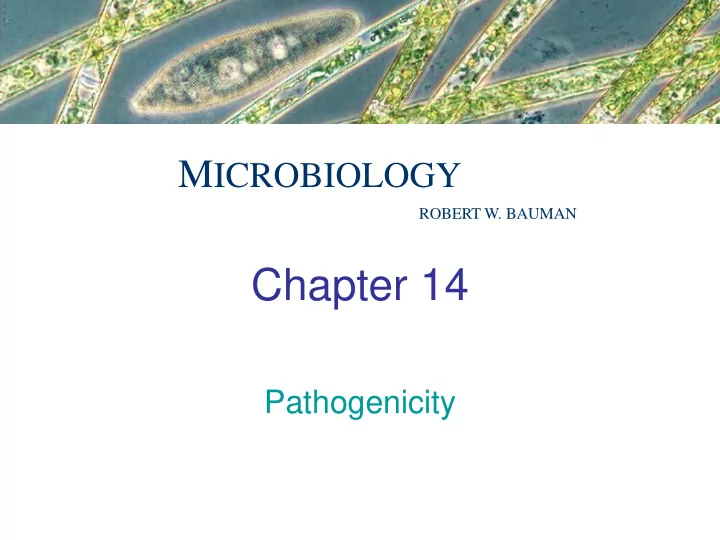

M ICROBIOLOGY ROBERT W. BAUMAN Chapter 14 Pathogenicity
Microbial Mechanisms of Pathogenicity • Pathogenicity -The ability to cause disease • Virulence - The extent of pathogenicity – Virulence Factors • Adhesion factors • Extracellular enzymes • Toxins • Antiphagocytic factors
Numbers of Invading Microbes • ID 50 : Infectious dose for 50% of the test population • LD 50 : Lethal dose (of a toxin) for 50% of the test population
Bacillus anthracis Portal of entry ID 50 Skin 10-50 endospores Inhalation 10,000-20,000 endospores Ingestion 250,000-1,000,000 endospores
Adherence • Adhesions/ligands bind to receptors on host cells – Glycocalyx Streptococcus mutans – Fimbriae Escherichia coli – M protein Streptococcus pyogenes – Opa protein Neisseria gonorrhoeae – Tapered end Treponema pallidum
Adhesins Proteins • Surface lipoproteins or glycoproteins, – called ligands, – bind host cell receptors • Ability to change or block the ligand or its receptor can prevent infection • Inability to make attachment proteins or adhesins renders the microorganisms avirulent
Exoenzymes – Coagulase Coagulate blood – Kinases Digest fibrin clots – Hyaluronidase Hydrolyses hyaluronic acid – Collagenase Hydrolyzes collagen – IgA proteases Destroy IgA antibodies – Siderophores Take iron from host iron-binding proteins – Antigenic variation Alter surface proteins
Penetration into the Host Cell Figure 15.2
Toxins • Toxin Substances that contribute to pathogenicity • Toxigenicity Ability to produce a toxin • Toxemia Presence of toxin the host's blood • Toxoid Inactivated toxin used in a vaccine • Antitoxin Antibodies against a specific toxin
Exotoxin Source *Mostly Gram + Metabolic product By-products of growing cell Chemistry Protein Fever? No Neutralized by Yes antitoxin LD 50 Small
Exotoxins Figure 15.4a
Exotoxins • A-B toxins or type III toxins Figure 15.5
Exotoxins • Superantigens or type I toxins – Cause an intense immune response due to release of cytokines from host cells – Fever, nausea, vomiting, diarrhea, shock, death
Exotoxins • Membrane-disrupting toxins or type II toxins – Lyse host’s cells by: • Making protein channels in the plasma membrane (e.g., leukocidins, hemolysins) • Disrupting phospholipid bilayer
Exotoxins Lysogenic Exotoxin conversion • Corynebacterium A-B toxin. Inhibits protein + diphtheriae synthesis. Membrane-disrupting. • Streptococcus pyogenes + Erythrogenic. • Clostridium botulinum A-B toxin. Neurotoxin + • C. tetani A-B toxin. Neurotoxin • Vibrio cholerae A-B toxin. Enterotoxin + Superantigen. • Staphylococcus aureus Enterotoxin.
Endotoxin Figure 15.4b
Endotoxins Gram – Source Present in LPS of outer Metabolic product membrane Chemistry Lipid Fever? Yes Neutralized by No antitoxin LD 50 Relatively large
Endotoxins Figure 15.6
Antiphagocytic Factors • Certain factors prevent phagocytosis by the host’s phagocytic cells – Bacterial capsule • Can be slippery making it difficult for phagocytes to engulf the bacteria • Often composed of chemicals found in the body and not recognized as foreign – Antiphagocytic chemicals • Some prevent fusion of lysosome and phagocytic vesicles • Leukocidins directly destroy phagocytic white blood cells
Cytopathic Effects of Viruses Table 15.4
Pathogenic Properties of Fungi • Fungal waste products may cause symptoms • Chronic infections provoke an allergic response • Mycotoxins – Neurotoxins: Phalloidin, α -amanitin • Amanita – Aflatoxin • Aspergillus
Pathogenic Properties of Fungi – Ergot toxin: alkaloid • Claviceps – Tichothecene toxins inhibit protein synthesis • Fusarium – Proteases • Candida, Trichophyton • Capsule prevents phagocytosis – Cryptococcus
Pathogenic Properties of Protozoa • Presence of protozoa • Protozoan waste products may cause symptoms • Avoid host defenses by – Growing in phagocytes – Antigenic variation
Pathogenic Properties of Helminths • Use host tissue • Presence of parasite interferes with host function • Parasite's metabolic waste can cause symptoms
Pathogenic Properties of Algae • Neurotoxins produced by dinoflagellates – Saxitoxin • Paralytic shellfish poisoning
Mechanisms of Pathogenicity Figure 15.9
Recommend
More recommend